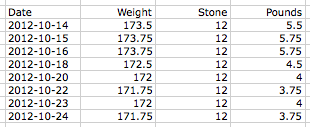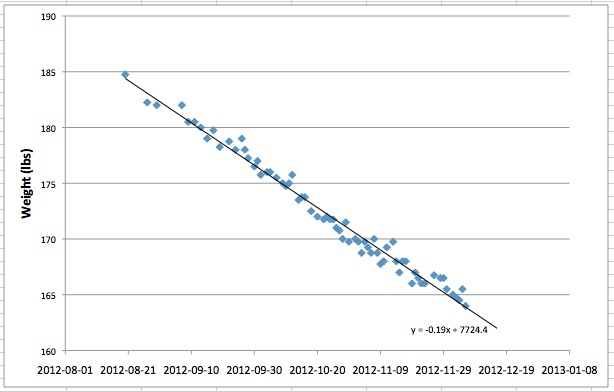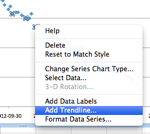Over the last four months I’ve lost just about two stone, at a steady rate of half a stone per month. The executive summary for how to lose weight is “eat the appropriate amount of food in a balanced diet”. I’ll expand on that slightly, with what worked for me.
I spend most of my work day sitting in front of a computer, and I have a sweet tooth. I got away with the latter for many years, but as my metabolism slowed down, my weight steadily increased. I knew I was overweight, and made half-hearted efforts to lose some weight, but I just enjoyed my food too much. Various things brought home to me that I really should lose some weight (not least of which was my five year-old son telling me I had a big tummy), my business partner showed me that with some will-power it wasn’t that hard, and a TV program gave me the final impetus.
Here’s my simple plan
- Have a specific goal (mine is 11.5 stone).
- Weigh yourself as regularly as you can, using accurate scales.
- Record your weight in a spreadsheet, and plot a graph.
- Eat sensibly.
- Kick-start your weight-loss to get the feedback loop going.
Have a specific goal
This doesn’t really need much explanation. You can find plenty of stuff to back this up online. You’re more likely to be successful if you have a specific and measurable goal.
Weigh yourself regularly
Weigh yourself daily if you can, or at least every other day. If you haven’t got accurate scales, get some. A digital display helps, as you want to track changes of a quarter or half of a pound. Weigh yourself at roughly the same time every day. I weigh myself in the morning before breakfast, but it doesn’t really matter when as long as you’re consistent.
Record your weight and plot a graph
The combination of near-daily weighing and plotting gives you a good feedback loop, so you see the negative effects of eating too much, and the benefits of sticking to the program.
Our scales read out in stones and pounds, so I created a simple spreadsheet:

In Excel you can then select the date and weight columns (including the headings), and select the marked scatter plot from the selection of charts. Here’s my plot for the last 4 months:

Adding a trend-line helps with the feedback loop. In Excel, click on one of the markers, then right-mouse click to bring up the menu:

In the options for the tend-line you can display the formula, as I’ve done here. This shows that on average I’ve lost 0.19 pounds per day. You can also extend the trend line a number of days, which shows where you’re heading for.
Eat sensibly
Eat more fruit and vegetables. Take it easy on starchy vegetables like potatoes, parsnips and the like. Take it easy on carbohydrates like bread and cereal. Cut back on sugar and fat. While you’re losing weight you’ll have to be more strict on some of these. I used to eat a lot of chocolate, snacks, cakes and biscuits; I haven’t cut them out completely, I just limit myself on any given day.
During the week a typical day might now be:
- For breakfast, a small bowl of cereal with fruit.
- For lunch, a bowl of soup, maybe with some bread (but less than I used to have). If I’m not on track, then I might skip the bread.
- Less restricted on dinner, but I generally eat less bread / noodles than before, and probably a bit more vegetables.
I’ll often still have chocolate in the evening (but quite a bit less than I used to!), or a piece of flapjack during the day (hard to resist the flapjack made by my business partner’s wife). I’m less careful at the weekend, though with a roast dinner I’ll eat fewer potatoes and more ‘good’ veg.
I don’t count calories, but I’m a lot more aware of the rough number of calories in some things. Over the four months I’ve improved my awareness of how much I need to eat, and how much I’m actually eating.
Kick-start the feedback loop
I found that the regular feedback of the graph makes a huge difference: you get a feeling for how much food you need to eat, you see the up-tick when you eat too much, and the improvement when you’ve had some “good days”. You can see on my graph that there are some data points where my weight seems to jump up; many of these are weekends or take-aways. Seeing those up-ticks made me more determined to have a few good days, to “keep the line going”.
When you start out you won’t have a trend though, and having a good start means you’re more likely to stick with it. Just before I started there was a TV program that talked about fasting and partial fasting. In my first week or so I had a couple of light days: a banana for breakfast, soup for lunch, and something light (but protein heavy) for dinner, like an omelette. Proteins take longer to digest, so you feel full for longer, and are less likely to snack.
Doing this has meant I can intentionally fall off the wagon, knowing that I’ll see an upswing, and will have to work a bit to bring things back on track. Around my birthday I indulged a bit more, though probably not as much as I might have in the past. But I felt like I did it in a controlled way. Plus my stomach feels like it has shrunk slightly over the last four months: I feel fuller, sooner now, which helps with self-regulation.
One final point: the earlier weight loss is easier. As you approach your target weight, the curve will start to plateau. You’re now eating close to the right number of calories per day, so you’ll lose less per day. Right now I feel like I’m working a little bit harder to get down the last few pounds. The game will change to maintaining weight, rather than losing it, so I probably won’t weigh myself as often.
Note that I’ve said nothing here about taking more exercise. I haven’t changed my exercise habits in the last four months. That can be one of my next projects!






